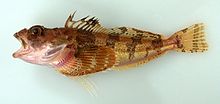| Butterfly sculpin | |
|---|---|

| |
| Conservation status | |
 Least Concern (IUCN 3.1) | |
| Scientific classification | |
| Domain: | Eukaryota |
| Kingdom: | Animalia |
| Phylum: | Chordata |
| Class: | Actinopterygii |
| Order: | Perciformes |
| Family: | Agonidae |
| Genus: | Hemilepidotus |
| Species: | H. papilio |
| Binomial name | |
| Hemilepidotus papilio (Bean, 1880) | |
| Synonyms | |
|
Melletes papilio Bean, 1880 | |
The butterfly sculpin (Hemilepidotus papillon) is a species of fish in the family Agonidae. It is found in the North Pacific Ocean.
Taxonomy
The butterfly sculpin was first formally described in 1880 as Melletes papilio by the American ichthyologist Tarleton Hoffman Bean with its type locality given as Saint Paul Island in the Pribilof Islands in the Bering Sea off Alaska. Bean proposed the monospecific genus Melletes' for the butterfly sculpin but later workers have placed it in the genus Hemilepidotus. The specific name papilio means "butterfly".
Description

The butterfly sculpin is reddish brown, yellow and white in color, with a metallic gold sheen. There are four blackish bars on the upper flanks which extend onto the dorsal fin, these bands vary in their definition. This fish has between 11 and 13 spines and 19 or 20 soft rays in its dorsal fins while there are no spines and between 16 and 18 soft rays in its anal fin.The scales in the ventral scale row are less than half the size of the scales in the dorsal scale row. The membrane of the first, spiny dorsal fin is deeply notched. There are four spines on the preoperculum with the fourt spine being simple. The maximum published fork length is 45 cm (18 in), and maximum weight of 960 g (34 oz).
Distribution
The butterfly sculpin lives in benthopelagic marine environments of the northern Pacific Ocean and the Sea of Okhotsk, in sandy or silty flat areas. It is usually found at depths of 41–80 m (135–262 ft) and water temperature from −0.9 to 10.7 °C.
Biology
Butterfly sculpins are predators feeding on gammarid amphipods, crabs, ostracods and small fish such as juvenile Alaska pollock. They are oviparous laying benthic eggs which hatch into pelagic larvae which settle on the substrate as juveniles at a minimum length of 4 cm (1.6 in).
References
- Stevenson, D. (2010). "Melletes papilio". IUCN Red List of Threatened Species. 2010: e.T154722A4618290. doi:10.2305/IUCN.UK.2010-4.RLTS.T154722A4618290.en. Retrieved 25 December 2022.
- Eschmeyer, William N.; Fricke, Ron & van der Laan, Richard (eds.). "Species in the genus Hemilepidotus". Catalog of Fishes. California Academy of Sciences. Retrieved 25 December 2022.
- Matthew L. Knope (2013). "Phylogenetics of the marine sculpins (Teleostei: Cottidae) of the North American Pacific Coast" (PDF). Molecular Phylogenetics and Evolution. 66 (1): 341–349. doi:10.1016/j.ympev.2012.10.008. PMID 23099148.
- Christopher Scharpf & Kenneth J. Lazara, eds. (11 July 2021). "Order Perciformes: Suborder Cottoidea: Infraorder Cottales: Families Trichodontidae, Jordaniidae, Rhamphocottidae, Scorpaenichthyidae and Agonidae". The ETYFish Project Fish Name Etymology Database. Christopher Scharpf and Kenneth J. Lazara. Retrieved 25 December 2022.
- Evermann, BW; Goldsborough, EL (1907). Fishes of Alaska. Bulletin of the Bureau of Fisheries, vol. 26, 1906. Washington, DC: Government Printing Office. Fig.60.
- ^ "Butterfly Sculpin: Hemilepidotus papilio (Bean, 1880)". Arctic Ocean Diversity. Retrieved 25 December 2022.
- Froese, Rainer; Pauly, Daniel (eds.). "Hemilepidotus papilio". FishBase. August 2022 version.
- ^ Tokranov, AM (2014). "Some features of biology of butterfly sculpin Melletes papilio (Cottidae) in the pre-Kamchatka waters of the Sea of Okhotsk". Journal of Ichthyology. 54 (8): 558–65. doi:10.1134/S0032945214050117. S2CID 255279240.
| Taxon identifiers | |
|---|---|
| Hemilepidotus papilio | |